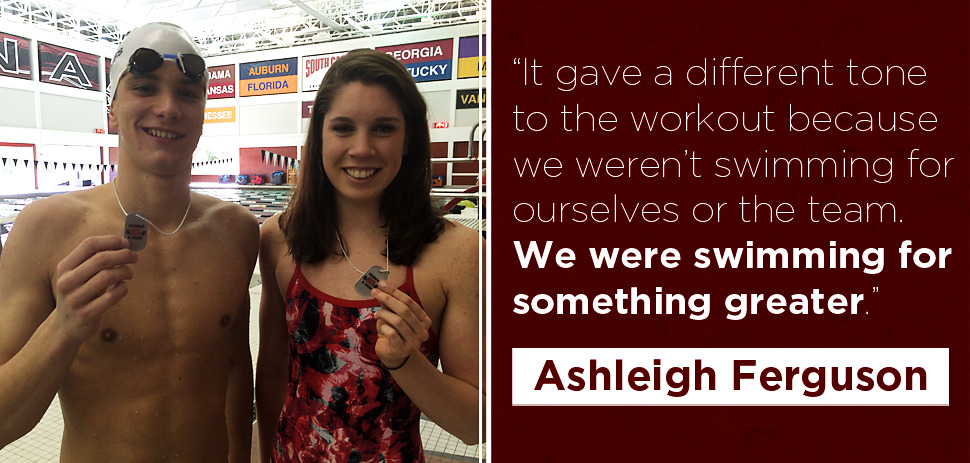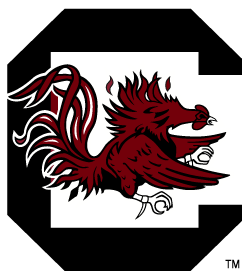
Heroes Inspire Gamecock Swimming and Diving
Jan. 21, 2015

Student-athletes train hard, but sometimes a little perspective can go a long way in creating a greater sense of purpose and commitment. South Carolina swimming and diving coach McGee Moody recently launched a series of “hero workouts” in which real-life heroes outside of the sports realm inspire the student-athletes to perform and prepare at a higher level.
“I went and researched about ten different people such as firefighters, soldiers and civilians who have shown sacrifice and selflessness,” Moody said. “At the start of practice I get the team together and talk about what this individual did and what kind of mindset it takes to make a decision like (South Carolina student and retired U.S. Marine) Kyle Carpenter, who threw himself on a grenade to save another Marine. We talk to them about that, and we’ll show them a video about the individual. The thought is to tell our team that you need to elevate your performance based on what you’ve heard in honor of this person. They sacrificed for someone else. So you elevate what you do today for this person.”
The goal of these weekly workouts is not only to have the student-athletes practice at a higher level, but also to have them put their own lives in perspective.
“We want them to think about the big picture,” Moody said. “What we’re starting to see now is that when other people come to college, they have their own little world or bubble. A lot of times they don’t see outside of that. We, as coaches, were talking about finding ways that we can interject perspective into every practice so that they realize there are bigger things going on than just what we’re doing in the water and in the classroom.”
“It really takes you out of that perspective where you realize your life isn’t that tough compared to these people,” said freshman Tomas Peribonio. “Even though you’re doing 14 workouts per week, and it’s four hours per day, other people go through much worse things. So you just put yourself through it. Everyone did such a good job because of that.”
The first workout required the student-athletes to swim five different sets of 600 yards as fast as possible, with sets of 100 repetitions of pushups, crunches, leg lifts and squats sandwiched in between each swimming segment. The workouts have already been well-received.
“Those 100 pushups in a row were really hard, and then jumping back into the pool and swimming the next 600 was insanely hard,” said junior Ashleigh Ferguson. “There’s no rest. You go from one thing to the next. You just kept going though. You couldn’t cheat yourself. When you finish, you’re glad it’s over, but you are glad you did it.”
“You go into a really hard set which asks you physically and mentally to be as tough as the hero in the workout,” Peribonio said. “You do that a couple of times and when you get back in the pool, you’ve never felt that way before because you’re so tired and physically exhausted. You just push yourself to think about the hero.”
We, as coaches, were talking about finding ways that we can interject perspective into every practice so that they realize there are bigger things going on than just what we’re doing in the water and in the classroom.
Coach McGee Moody
The hero for one of the initial workouts was Navy Lieutenant Brad Snyder, who earned two gold medals and a silver at the 2012 Paralympic Games in London, England. Snyder lost his sight after throwing himself on two soldiers to protect them from an explosive device detonation.
“His whole story is really breathtaking,” Peribonio said. “Putting yourself into that stage of mental toughness is hard to do. It definitely had an impact on me because Brad Snyder was an EOD specialist for the Navy. That’s the same thing my brother does in the Navy. He hasn’t been deployed yet, but it brought a little more connection to myself and that toughness that it takes to be that person.”
“It gave a different tone to the workout because we weren’t swimming for ourselves or the team,” Ferguson added. “We were swimming for something greater. I was just really impressed with his story. Coach Moody was telling Lt. Snyder about the workout that we were going to do, and he said he was going to do it also. It was really motivating.”
Special dog tags etched with “Gamecocks Swimming and Diving” on one side and the words “Discipline, Teamwork, Sacrifice, Commitment, Success, Communication, Leadership, Excellence” on the other side were made for those who excel in the hero workouts. At the end of the practice one male and one female student-athlete is awarded the dog tags and a certificate with the individual hero’s name on it along with what was accomplished in the workout.
“I guess it’s a little bit of bragging rights to get the dog tags, but when you’re going through the workouts it’s more of a team thing,” Peribonio said about receiving the dog tags. “You get out of the water and you’re doing your pushups and someone else is just getting out of the water cheering you on even though they’re behind you and you’re cheering them on. Completing the workout is what you brag about as a team. We’re all so happy together when we finish the workout.”
The workouts may be more challenging than a regular practice, but the Gamecocks are seeing the benefits.
“Coaches tell us to make ourselves uncomfortable at practice so when you get to the SEC meet or the NCAAs, and something goes wrong, you’ve been there before,” Peribonio said. “It takes you to uncomfortable levels and to a different level of being tired. So it really prepares you. You’re getting a little more purpose into your workout. Each workout will be different. So sometimes you’ll be at the front of the pack and sometimes you will be at the back. No matter where you are though, the whole team is with you and that’s what makes it special.”
While the concept of the workouts is not unique, Moody is confident the workouts will have the desired effect.
“We took the idea from Crossfit, but we developed the incentive,” Moody said. “The thought is to work out for someone maybe who can’t; someone who sacrificed everything. It’s ongoing and developing and we’ll see what it turns into.”
The staff also came up with the motto for those who received the dog tags, “This reward was not given to me; it was earned.”
“Any time you can add outside motivation, student-athletes will grab on to that,” Moody said. “Our coaches are really getting into finding the sources for motivation.”












